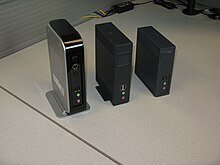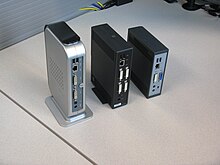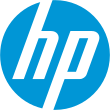Teradici
 | |
| Company type | Subsidiary |
|---|---|
| Industry | Computer software, Computer hardware |
| Founded | British Columbia, Canada, 2004 |
| Founder | Dan Cordingley Dave Hobbs Ken Unger Maher Fahmi |
| Headquarters | Burnaby, British Columbia, Canada |
| Products |
|
Number of employees | 200+ |
| Parent | HP Inc. |
| Website | www.teradici.com |
Teradici Corporation was a privately held software company founded in 2004,[1] which was acquired by HP Inc. in October 2021.[2] Teradici initially developed a protocol (PCoIP) for compressing and decompressing images and sound when remotely accessing blade servers, and implemented it in hardware.[3][4] This technology was later expanded to thin clients/zero clients[5] for general Virtual Desktop Infrastructure.[6][7] Teradici's protocol or hardware is used by HP,[8] Dell-Wyse,[9] Amulet Hotkey, Samsung, Amazon Web Services,[10] Fujitsu,[11] and VMware.
On 27 July 2021, HP Inc announced that it had signed a definitive agreement to acquire Teradici on undisclosed terms, with the deal set to close in calendar Q4, 2021.[12]

History
[edit]Teradici was founded in 2004 by Dan Cordingley, Dave Hobbs, Ken Unger and Maher Fahmi.[13][14] It operated in stealth mode until 2007 when they announced their first products, a blade server card and a small hockey puck shaped client, using a proprietary chip which implemented the PCoIP protocol.[15] In 2008, VMware announced it was licensing Teradici's PCoIP protocol. Teradici developed a software implementation of PCoIP, which VMware started shipping in VMware View 4.[16]
The Teradici name originated from a previous company the founders were incubating. That company's product involved a 100-gigabit data center networking device. One-tenth of a tera is a deci, but "Teradeci" didn't roll off the tongue. "Teradici" was unique, sounded better and the domain name was available at the time.[17]
PCoIP Protocol
[edit]PC-over-IP (PCoIP) is a proprietary remote display protocol developed by Teradici.[18] The protocol is available in hardware and in software. In 2008, VMware licensed Teradici's PCoIP protocol,[1][19][20] and supports it in VMware Horizon View.[21] In 2013 Amazon licensed the PCoIP protocol for use in AWS Amazon Workspaces.[10][22][23][24][25][26]
PCoIP is a UDP-based protocol that is host rendered, multi-codec and dynamically adaptive.[clarification needed] Images rendered on the server are captured as pixels, compressed and encoded and then sent to the client for decryption and decompression. Depending on the image, different codecs are used to encode the pixels sent since techniques to compress video images differ in effectiveness compared to those for text.[18][27] The protocol also dynamically adapts its encoding based on the available bandwidth. In low-bandwidth environments it uses lossy compression where a highly compressed image is quickly delivered, followed by additional data to refine that image, a process termed "build to perceptually lossless". The default is to use lossless compression which is used when there is minimal network congestion or when explicitly configured, as might be required for scenarios where image fidelity is more important than conserving bandwidth, e.g. for medical imaging.[28][29]
Comparing PCoIP vs RDP
[edit]- Using PCoIP and RDP as a VPN: both PCoIP and RDP protocols can be used in place of a company’s Virtual Private Network, when a corporate firewall is not available or is deactivated.
- High Security and Encryption Level in Connections: using a corporate DMZ, the users can make secure and encrypted connections to Access Points or servers via either PCoIP or RDP.
- Security with AES: Both PCoIP and RDP support Advanced Encryption Standard 128-bit by default, adding an extra layer of security in connections. Although, you can change the encryption key cipher to AES-256 in PCoIP.
- Bandwidth Reduction: This capability is available on PCoIP protocol in order to optimize the bandwidth usage on WAN and LAN to increase its speed. Bandwidth will be evaluated by Remote Desktop Commander to track the RDP number which depends on your setting (color, depth, etc.).
Products & Solutions
[edit]OEM products
[edit]- PCoIP Zero Client SoC (System on a Chip): SoCs for OEMs to implement Zero clients either with the Teradici-developed Tera1 or Tera2[30] chip, which implement the PCoIP protocol.

- PCoIP Workstation 1:1 host SoC (System on a Chip): An SoC allowing an OEM to implement a PCIe card which plugs into a workstation (typically a blade computer), allowing it to be remoted and controlled by a client device, either a PCoIP Zero Client or PCoIP Software Client. The connection is 1:1, meaning one host system to one remote user; it is not virtualized or shared and can capture the output from a GPU for full HD and 2K remoting along with redirecting audio and USB peripherals.
- PCoIP software clients: Software implementation of the PCoIP protocol for flexible client device support. Select OEMs include this in their products for x86 and ARM-based thin clients. This is also the basis for the VMware and AWS Amazon Workspaces[22] software clients for Windows, Mac, Linux, iOS and Android which use Teradici-developed core PCoIP protocol and decoding technology.
Direct Products
[edit]- Teradici APEX 2800 server offload card: A PCIe coprocessor Hardware Accelerator board for VMWare Horizon offloading the compression and encryption of graphics and audio to Horizon Software Client or PCoIP Zero Client improving server consolidation in a VDI environment.[31]
- PCoIP management console: A web-based management tool for administrative control of PCoIP Zero Client devices from a central console.
- Workstation Access Software: Enables remote access via PCoIP Software Client or PCoIP Zero Client to a physical Windows PC or Virtual Machine in the Cloud.
- Host Card.
See also
[edit]- Comparison of platform virtualization software
- Desktop virtualization
- x86 virtualization
- Virtual machine
- Virtual appliance
- Thin client
- Comparison of remote desktop software
References
[edit]- ^ a b Mellor, Chris (10 November 2009). "VMware brings fat graphics to thin clients". The Register. Situation Publishing. Retrieved 12 May 2013.
- ^ Dignan, Larry (July 27, 2021). "HP buys Teradici, guns for remote high performance computing". ZDNet. Retrieved 30 July 2021.
- ^ Thibodeau, Patrick (25 June 2007). "Blade Vendors Look to Make Thin Clients More PC-Like". Computerworld. Retrieved 27 May 2013.
- ^ Miller, Michael (23 July 2007). "A New Twist on Blade Computing". ForwardThinking. PCMag. Retrieved 12 May 2013.
- ^ Doyle, Paul; Mark Deegan; David Markey; Rose Tinabo; Bossi Masamila; David Tracey (July 2009). "Case Studies In Thin Client Acceptance". Ubiquitous Computing and Communication Journal. Special Issue on ICIT 2009 Conference - Applied Computing. 4 (3): 587. ISSN 1992-8424. Retrieved 27 May 2013.
- ^ Haff, Gordon (November 9, 2009). "VMware elevates its desktop virtualization view". CNET. Archived from the original on 12 January 2014. Retrieved 12 May 2013.
- ^ Lohr, Steve (24 September 2007). "New Ideas in Thin Computing – I". Bits: The Business of Technology. The New York Times. Retrieved 22 May 2013.
- ^ Teradici. "Teradici Blog | HP". connect.teradici.com. Retrieved 2020-06-08.
- ^ Myslewski, Rik. "Dell uncloaks novel workstation trio, plops one into cloud". The Register. Situation Publishing. Retrieved 22 May 2013.
- ^ a b Berger, Gunnar (November 2013). "The DaaS floodgates are open thanks to Amazon WorkSpaces". Gartner Blog Network. Gartner. Retrieved 16 November 2013.
- ^ Shukla, Anuradha. "Fujitsu Provides Teradici's PCoIP in its CELSIUS Workstations". TMCnet. Retrieved 22 May 2013.
- ^ Press release, HP, Inc, 27 July 2021
- ^ Shaw, Gillian (16 June 2007). "Bold move to control PC security and software: Four high-tech veterans create circuit card that brings big boys' backing". Vancouver Sun. Retrieved 3 June 2013.
- ^ Drexhage, Glenn (2006). "$10 million funding round kick-starts Burnaby semiconductor company" (PDF). Business In Vancouver. Retrieved 28 January 2014.
- ^ "Is Teradici's PC-Over-IP The Next Big Thing?". Virtualization Journal. SYS-CON Media. June 2007. Archived from the original on 2 February 2014. Retrieved 3 June 2013.
- ^ wponder (6 December 2009). "PCoIP Zero Client and VMware View 4". Virtual Desktop Blog. VMware. Archived from the original on 15 June 2013. Retrieved 3 June 2013.
- ^ Rogers, Bruce (21 May 2014). "Dan Cordingley's Teradici Enables the Virtual Workspace". Forbes. Retrieved 21 May 2014.
- ^ a b Stuart, Greg. "PCoIP: What Is PC-over-IP and How Does It Work?". Petri IT Knowledgebase. Archived from the original on 22 May 2013. Retrieved 30 May 2013.
- ^ "VMware Announces Strategic Licensing and Co-development Agreement with Teradici for True Remote PC User Experience Further Bolstering its vClient Initiative". VMware News Releases. VMware. Retrieved 14 May 2013.
- ^ Ricknas, Mikael. "Desktops Will Move to the Cloud, VMware Exec Says". PCWorld. IDG News Service. Retrieved 12 May 2013.
- ^ O'Doherty, Paul (2012). VMware View 5: Building a Successful Virtual Desktop. Prentice Hall. p. 8-3. ISBN 9780132983686.
- ^ a b Brian Madden (11 December 2013). "BrianMadden.com Live Podcast #52, with guest Dan Cordingley, CEO of Teradici". BrianMadden.com (Podcast). TechTarget. Retrieved 6 January 2014.
- ^ "Amazon WorkSpaces Product Details". Amazon Web Services. Amazon. November 2013. Retrieved 13 November 2013.
- ^ Don Clark (November 2013). "Amazon Plans to Offer Desktops in the Cloud". Wall Street Journal. Retrieved 13 November 2013.
- ^ Vaughan-Nichols, Steven (November 2013). "Amazon want you to run Windows 7 on its cloud with WorkSpaces". ZDNet. CBS Interactive. Retrieved 14 November 2013.
- ^ Bennett, Nelson (November 2013). "Burnaby's Teradici teams up with Amazon to eliminate the need for desktop computers". Business In Vancouver. BIV Media Group. Archived from the original on 8 December 2013. Retrieved 14 November 2013.
- ^ Groves, Randy. "BriForum 2014 Boston - Randy Groves - Deep Dive into PCoIP Technology". brianmadden.com (Podcast). TechTarget. Retrieved 8 May 2015.
- ^ "VMware View 5 with PCoIP: Network Optimization Guide" (PDF). VMware. p. 4. Retrieved 5 June 2013.
- ^ "PCoIP technology". Teradici. Retrieved 5 June 2013.
- ^ Harding, Christoph. "Teradici Announces Next-Generation Tera2 PCoIP® Zero Clients". That's my view. Retrieved 26 May 2013.
- ^ Langone, Jason (2012). Vmware View 5 Desktop Virtualization Solutions. Packt Publishing Ltd. p. 82. ISBN 9781849681124.
- Canadian companies established in 2004
- Virtualization software
- Remote desktop protocols
- Software companies established in 2004
- Companies based in Burnaby
- Thin clients
- Software companies of Canada
- 2004 establishments in British Columbia
- 2021 mergers and acquisitions
- Hewlett-Packard acquisitions
- Canadian subsidiaries of foreign companies

